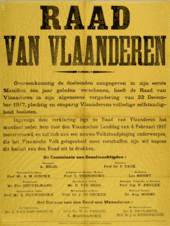Raad van Vlaanderen

The Council of Flanders (Dutch: Raad van Vlaanderen or RVV) was a quasi-independent government created on 4 February 1917 by members of the "activist" (or "maximalist") faction of the Flemish Movement in German-occupied Belgium.[1]
Its founders, who included Pieter Tack and August Borms, wanted to realize the independence of Flanders from Belgium using German support provided as part of the Flamenpolitik. The Council originally included 46 members, but eventually expanded to include 93. Despite hopes that the Council would be allowed full legislative powers, it never became more than a consultative body. It also suffered from internal factionalism and infighting.[1]
On 22 December 1917, the council proclaimed the autonomy and independence of Flanders.[2] The appointment of Georg von Hertling, who opposed the Flamenpolitik, as German chancellor in November 1917 reduced support for the RVV among the German administration.[2] The surrender of Germany in November 1918 led to the end of the Council. In the aftermath of the war, many of the members of the RVV were arrested and imprisoned as collaborators.
See also
References
- 1 2 Amara et al. 2004, p. 24.
- 1 2 Amara et al. 2004, p. 25.
Bibliography
- Amara, Michaël; Roland, Hubert, eds. (2004). Gouverner en Belgique occupée. Comparatisme et Société 1. Brussels: College of Europe. ISBN 978-90-5201-238-4.